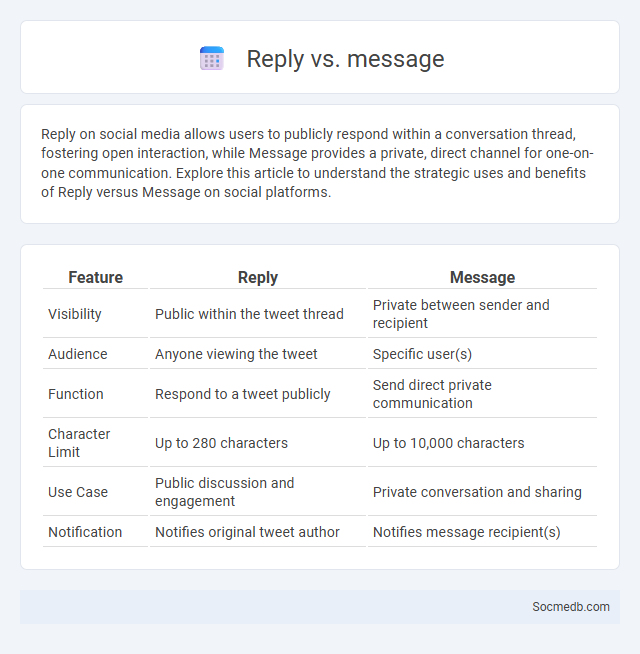
Photo illustration: Reply vs Message
Reply on social media allows users to publicly respond within a conversation thread, fostering open interaction, while Message provides a private, direct channel for one-on-one communication. Explore this article to understand the strategic uses and benefits of Reply versus Message on social platforms.
Table of Comparison
| Feature | Reply | Message |
|---|---|---|
| Visibility | Public within the tweet thread | Private between sender and recipient |
| Audience | Anyone viewing the tweet | Specific user(s) |
| Function | Respond to a tweet publicly | Send direct private communication |
| Character Limit | Up to 280 characters | Up to 10,000 characters |
| Use Case | Public discussion and engagement | Private conversation and sharing |
| Notification | Notifies original tweet author | Notifies message recipient(s) |
Understanding Replies and Messages: Key Differences
Understanding replies and messages on social media platforms reveals that replies are public responses linked to specific posts, fostering open conversations within a community, while messages are private communications exchanged between users for direct interaction. Replies contribute to engagement metrics by increasing visibility and encouraging dialogue, whereas messages emphasize personalized communication, enhancing user relationships and support. Analyzing these differences helps businesses optimize content strategies and improve customer service efficiency on social channels.
What is a Message?
A message in social media is the core unit of communication, consisting of text, images, videos, or a combination that conveys information or emotions to your audience. It serves as the primary vehicle for engagement and interaction, enabling users to share thoughts, updates, and promotions. Crafting a clear and compelling message increases visibility and drives meaningful connections on social platforms.
Defining a Reply: Meaning and Usage
A reply on social media is a direct response to a specific post or comment, allowing users to engage in conversations and provide feedback. It functions as an interactive tool for communication, fostering community engagement and enhancing dialogue clarity by maintaining context within threads. Effective replies often include relevant hashtags, mentions, or multimedia elements to increase visibility and user interaction.
Types of Replies: Direct, Threaded, and Quoted
Direct replies target the original post, providing immediate responses visible under the main content. Threaded replies create nested conversations, allowing users to follow specific dialogue streams within a broader discussion. Quoted replies include portions of the original message, enabling contextual engagement and clearer reference to specific points in social media interactions.
Message vs Reply: A Comparative Analysis
Message and reply functions on social media platforms serve distinct communication roles; messages are typically original postings or direct communications, while replies are responses that engage with those messages. Your engagement metrics often reflect the interplay between messages and replies, as higher interaction through replies can boost visibility and foster community. Understanding the semantic differences between messages and replies can enhance your social media strategy by optimizing content for targeted responses and meaningful conversations.
Best Practices for Sending Messages
Craft clear, concise messages tailored to your audience to maximize engagement on social media platforms. Use personalized greetings and include a compelling call to action to encourage interaction with your brand. Your messaging should be timely and relevant, leveraging platform-specific features such as emojis, hashtags, and multimedia to enhance visibility and response rates.
When to Use Replies Instead of New Messages
Replies are ideal for continuing an existing conversation or addressing a specific comment in a social media thread, keeping the context clear and organized. You should use replies when you want to maintain the flow of interaction and make it easy for others to follow the discussion. Starting new messages is better suited for introducing unrelated topics or reaching out to someone privately.
The Role of Context in Messaging and Replies
Context in social media messaging and replies significantly shapes communication effectiveness by providing background that influences interpretation and tone. Real-time interactions depend on understanding prior conversations, user intent, and cultural nuances to prevent misunderstandings and foster meaningful engagement. Platforms like Twitter and Facebook utilize threaded replies and contextual cues to help users track dialogues and maintain coherence in multi-user discussions.
Common Mistakes: Reply vs Message Misuse
Confusing replies with direct messages often leads to privacy breaches and miscommunication on social media platforms. Users mistakenly send sensitive information in public replies instead of private messages, exposing content to unintended audiences. Proper understanding of message functions enhances communication accuracy and protects user privacy.
Enhancing Communication: Choosing Between Reply and Message
Enhancing communication on social media requires understanding when to use reply versus message options to optimize user interaction and privacy. Replies allow public engagement and broader conversation visibility, ideal for community-building and real-time discussions on platforms like Twitter and Facebook. Direct messages provide a private, secure channel for personal conversations or sensitive information exchange, crucial for maintaining confidentiality and fostering one-on-one communication.
 socmedb.com
socmedb.com